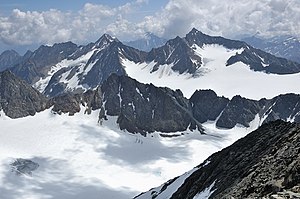Schwarzenbergferner
| Schwarzenbergferner | ||
|---|---|---|
|
The Schwarzenbergferner from the cabinet bird |
||
| location | Tyrol , Austria | |
| Mountains | Stubai Alps | |
| Type | Valley glacier | |
| length | 2.9 km (2010) | |
| surface | 1.84 km² (2010) | |
| Exposure | Nutrient area: southeast, feeding area: southwest | |
| Altitude range | 3490 m above sea level A. - 3030 m above sea level A. (2010) | |
| Coordinates | 47 ° 2 '46 " N , 11 ° 6' 38" E | |
|
|
||
| drainage | Schwarzenbergbach → Fischbach → Ötztaler Ache → Inn | |
The Schwarzenbergferner is a glacier in the Stubai Alps in Tyrol .
location
The Schwarzenbergferner flows from the ridge that runs between Schlossogel ( 3497 m ) and Schrandele ( 3392 m ) first to the south-east, then south to south-west to the Sulztal . It drains over the Schwarzenbergbach to the Fischbach and further into the Ötztaler Ache . In the west, it is bounded by the flank of the cabinetogel; in the east, a narrow ridge, running from the western Schwarzenbergspitze to the Schrandele, separates it from the Alpeiner Ferner , which drains northeast into the Oberbergtal .
retreat
At its last peak at the end of the Little Ice Age around 1858, the Schwarzenbergferner and the Sulztalferner formed a common tongue . There is a striking moraine arch there today . Since then, the Schwarzenbergferner has withdrawn by around 2 kilometers and 600 meters in altitude, although the retreat, as with other Alpine glaciers, has not been continuous, but has been repeatedly interrupted by phases of stagnation or advance. In the forefield of the glacier there are stagnation and compression moraines from the 1870s, 1920s and 1980s. Since the last advance phase, caused by cool summers and snowy winters, from 1974 to 1985, the glacier has been continuously losing length; between 1985 and 2016 it retreated by 340 m.
Glacier foreland
The glacier foreland, which has been free of ice since 1858, represents an extreme and sensitive natural habitat that allows the study of settlement dynamics and vegetation development on a previously uninhabited site. In the early stages of succession near the current glacier tongue, after a few years of freedom from ice, wind - dispersed species such as alpine rockcress , single-flowered hornwort , creeping clove root , alpine sourling , opposed saxifrage , alpine bluegrass and limp bluegrass can be found . There are already 19 different species of vascular plants on the ice-free areas for around five years .
The ice-free areas, which have been ice-free for around 60 years, are characterized by Alpine lichen , herbs such as low Ruhr herb and Alpine hawkweed as well as herb willow in addition to the pioneer species.
In the approximately 80 years the ice-free areas colonizer missing as glacier buttercup , Alpine Spring Minimize , Androsace alpina or Alpine toadflax for are species such as alpine thistle , Euphrasia minima and Haller's fescue added. There are sometimes over 30 species per 10 m², which cover 20 to 25% of the soil.
Pioneer lawns with species such as alpine bluegrass, ear of corn grass , Scheuchzer's bellflower , stiff-haired dandelion and various types of clover grow on the ice-free areas for around 110 years . Shrubs are also increasingly found here, especially the Swiss willow and the rust-leaved alpine rose . On the more than 100 years of ice-free areas, the transition to alpine (dwarf) shrub communities takes place, around half of the vegetation here is formed by shrubs, with the above-mentioned shrub types being added to others such as silk willow or hermaphrodite crowberry .
Web links
Individual evidence
- ^ A b c World Glacier Monitoring Service (WGMS): Fluctuations of Glaciers 2005–2010 (Vol. X). Zurich 2012, p. 119 doi : 10.5904 / wgms-fog-2018-11
- ↑ a b c d e Thomas Loher, Katharina Sextl, Friederike Grüninger, Thomas Fickert: Glacier retreat and vegetation development in the run-up to the Schwarzenbergferner (Stubai Alps, Tyrol) since the end of the Little Ice Age. In: Yearbook of the Association for the Protection of the Mountains (Munich), 78th year 2013, pp. 139–164 ( PDF; 2.2 MB )
- ↑ Andrea Fischer, Gernot Patzelt, Hans Kinzl: Length changes of Austrian glaciers 1969-2016. Institute for Interdisciplinary Mountain Research of the Austrian Academy of Sciences, Innsbruck, PANGEA, 2016 doi : 10.1594 / PANGEA.821823

